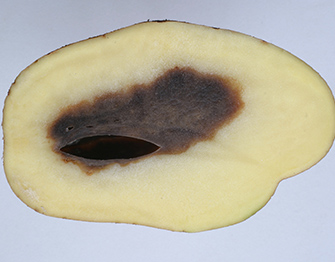Please click here to access the main AHDB website and other sectors.
- Home
- Knowledge library
- Blackheart
Blackheart
Blackheart is an internal defect caused by low oxygen and high carbon dioxide levels in the tuber and occurs where the respiration demand for oxygen exceeds the available supply.

This might be due to low oxygen levels in the environment, such as field flooding, or high tuber respiration rates, usually in response to temperature extremes.
Crops are most vulnerable around harvest time where respiration rates are likely to be higher.
Blackheart is often first visible at the centre of the tuber where a dark grey to black tissue discolouration indicates necrosis. Affected tissue is firm to the touch and may smell of sweet alcohol if warm.
Cavities can form within the darkened area, which is usually isolated from the surface. However, blackheart symptoms can reach the surface appearing as dark sunken patches and disease infections are likely where the surface is broken.
In the field, promote good soil drainage and avoid excessive irrigation. Do not delay harvest in hot soils.
Positive store ventilation will improve gas exchange, dry crops quicker and help prevent condensation events.
Avoid a build-up of carbon dioxide in excessively sealed stores and any temperature extreme (above 30 C or near freezing).
Be vigilant for any crop stress that might stimulate excessive respiration.

